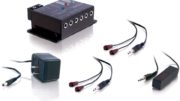You may not worry about this at home, but let’s say that you want to deliver signal to 200 TVs. You know that you’ll lose signal strength purely through the long cable runs, and you know that you’ll also lose it every time you split or tap off the signal to go to another TV. At some point the signal will be too weak for you to use. What can you do?
Add another amplifier
That’s where distribution amplifiers like this Blonder Tongue BIDA series come in. They are designed to strengthen a signal that’s already come through a cable and give it enough “oomph” to go up to another 500 feet or through about 9 TVs. That’s all great, but in our example we have to do a lot more than 9 TV.
In many cases you can add another amplifier when the signal gets too weak and then you’re off again adding even more TVs or more cable. However, there is a “point of no return” where it becomes impossible to keep amplifying.
It’s all about noise.
When you’re distributing a digital signal, noise is the most important thing. A digital signal is either a 1 or a 0 and it doesn’t matter how strong the signal is really. It only matters if you can tell the difference between a 1 and a 0.
Noise is something that’s inherent in all electronic devices, all connectors, and all transmission. Without getting all philosophical, it’s the electrical expression of the chaos of the universe. It’s everywhere, and once it creeps in you really can’t get rid of it unless you recreate the signal completely.
Noise is like a bad magic trick.
The way I like to explain noise is, think about those magicians who try to escape from a box that’s filling with water. The air in the box is the signal and the box is the noise. As they keep adding water, there’s less room for air and eventually there isn’t enough for the magician to breathe. He or she can’t stay in there for long. That’s similar to the way noise is on a cable. As there’s more and more of it, there’s less room for the signal and eventually the whole thing stops working. Adding an amplifier makes the box bigger so there’s more room for air, but it doesn’t take away the water. In fact it adds more water. Eventually you just can’t make the box any bigger.
Signal to Noise Ratio
The important thing to see when you’re amplifying is that the signal to noise ratio is high enough. A typical standard for commercial use would be that the signal is 25db higher than the noise. That translates pretty roughly to the signal being about 18 times stronger than the noise. Any more signal than that and you’re totally fine. Any more noise than that and you can’t guarantee the TV’s tuner will be able to work properly.
When using a typical 30dB distribution amplifier, the signal is increased by 30dB on the high end (there’s more to that but it belongs in another article.) The noise is increased by 6dB on the high end. You have more signal for sure, but that noise is going to keep creeping up on you. As the signal drops due to adding more and more cable and TVs, the noise stays constant and eventually you run into problems.
Rule of thumb, vs. measuring
A lot of commercial installers will say it’s a good rule of thumb not to amplify a line more than three times. That’s a good rule if you’re planning; that would mean each run could have as many as 27 TVs. A splitter or launch amplifier at the headend would provide you as many master runs as you need to get to the number of TVs you have.
All of that is just theory. You can plan a lot of stuff on paper ahead of time but what you really need to do is check signal-to-noise ratio almost constantly as you install, tweaking and processing to see what will work for you. In some cases you can get up to five amplifiers in a row, it’s not impossible depending on how strong the signal is coming out of the headend. It’s a risk, though.
Call for backup
The best option is to get professional installers involved. If you’re a pro yourself, the best thing to do is use a quality meter and check, check, check. Of course, if you need help finding a person or just getting the right meters, give the fine folks at Solid Signal a call at 888-233-7563. If it’s after business hours, fill out the form below. We’ll get right back to you!





